Seasons – Summer 2017
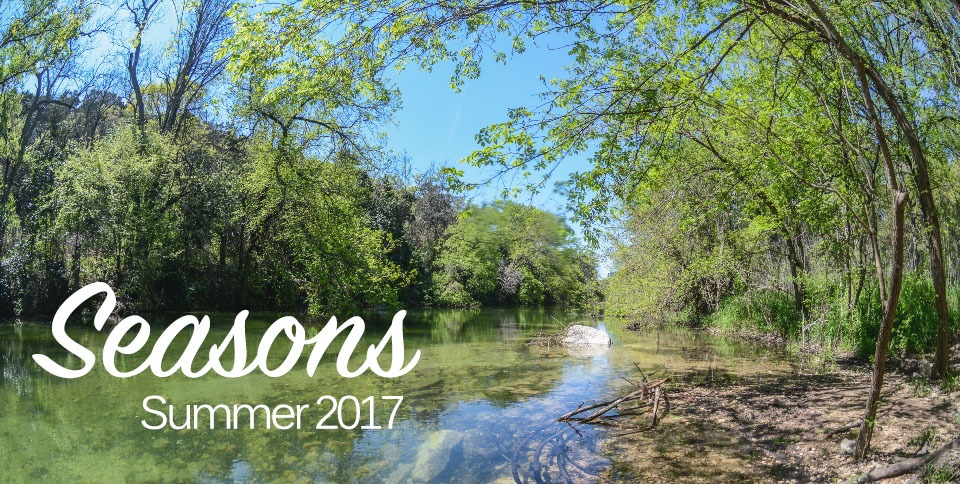
From the Plateau Land & Wildlife Management Team,
The year seems to be flying by and another hot Texas summer is upon us again. Although this spring has been fairly wet allowing the flora and fauna to thrive, we all know the dry season is now here. As we prepare ourselves for the heat and all the fun activities that may include, we must also remember how summer can affect our land. Now is the time to set up and check on any water supplements you have on your property.
As you kick back, relax and soak up this hot Texas sun, please scroll through this issue of Seasons where we provide you with useful information about notices of appraised value, the thrills of birding and reviewing your seasonal activity checklists.
We hope you enjoy the read and everything this summer has to offer, and if there’s any way Plateau can help you protect, enhance or better enjoy your land during this special season, just give us a call. We’re here when you need us.
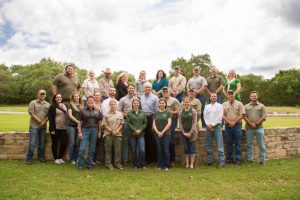 Until next season and Seasons,
Until next season and Seasons,
The Plateau Team
Table of Contents
Notices of Appraised Value
Looking Back at 20 Years of Working with Texas Landowners
Birdwatching: A Tale from the Field
Summer Wildlife Management Activity Checklist
The Presents of Presence
Plateau Summer Webinar Series
Service Spotlight: Annual Reports
A Recap of the Texas Legislative Session
Plateau Land Group Featured Listing
Notices of Appraised Value
By Sarah Kahlich, AWB ®, Senior Wildlife Biologist & Registered Property Tax Consultant
Around May 1st every year, central appraisal districts mail notices of appraised value to property owners. Often, the first thing a landowner notices is there is no value in the “Productivity Value of Ag/Timber Land” for the current year when there was the year before. This may cause increased heart rate and confusion to the person reading the notice. The most common first thought to cross one’s mind is, “Oh no! My wildlife valuation has been denied!!!”
The appraisal district is required by law to mail these ‘Notices of Appraised Value’ to landowners. They do this so you will be aware of the market value of your property. If the county requested a new ag/wildlife application you are either a new landowner or you submitted an updated application. Many appraisal districts remove the agricultural value from their systems until they have a chance to review and approve the wildlife or agricultural application.
For a landowner who has not recently purchased their property or has not filed an open space application in the current year, a zero productivity value is a cause for concern and a reason to protest. If you submitted an application in the current year and your wildlife or ag valuation was to be denied, the county is required to send a certified denial letter. The letter must state why it was denied and give you 30 days (typically) to protest their decision. Denial letters should always be protested, even if the issue seems to be settled with an appraisal district. When you file a protest, it will protect your rights as a landowner and provide an evidence trail that the issue was resolved.
Remember that even if your property has an ag or wildlife valuation, it still has a market value. You should pay attention to how much your market value has increased in the current year. If you feel the increase is excessive it is important that you protest the new market value with your appraisal district by the deadline mentioned in the letter (usually May 31st or 30 days from the date of the notice, whichever is later). Watch out for new improvements appearing on the rolls; sometimes the steep increase in value is a result of a new structure which was not reflected on the previous year’s rolls. Remember that your house and land around it will be taxed at market value, even if you have an ag/wildlife valuation.
Why is protesting the market value important even though you currently have an ag/wildlife valuation on the property? If you were to ever lose your valuation you would pay taxes on the market value. If you decide not to participate in wildlife management or agriculture in the future, the county can hit you with 5 years of rollback taxes, which is the difference between your open-space taxes and the market value taxes plus interest. By the time rollback hits it is too late to protest the market value increase in prior years. Whenever you’re in doubt, you should protest before the deadline. A protest can always be revoked, but once the protest deadline has passed you are stuck for the year.
Plateau offers a service providing property tax consultation in matters dealing with your ag or wildlife valuation. We’re uniquely qualified to perform this service because we have biologists on staff who are also registered property tax consultants – this means Plateau professionals have a greater understanding of your property tax issues relative to ag and wildlife management. Plateau clients with any questions or concerns about their Notice of Appraised Value can contact us and send a copy for further evaluation.
Back to TopBack to Top
Looking Back at 20 Years of Working with Texas Landowners
By Beyrl Armstrong, Co-founder & Senior Consultant
Plateau Land & Wildlife Management turned 20 in January. As milestones like these are celebrated, it’s good to look back at the history of our organization and take stock of where we started, where we are today and how we got here.
In 1996, the people of the State of Texas voted to amend the constitution to make wildlife management a qualifying form of agriculture as it applies to Open Space Valuation. No one really knew what that meant and how to qualify land through this new law. My partner, David Braun, and I saw an opportunity to work with landowners to convert their land from standard agriculture to wildlife management. We canvassed several landowners and found that they were reticent to be the “pioneers” until someone else had successfully gone through the application process. When we first tried to submit applications to several appraisal districts, they too were unsure of how the process was supposed to work. At that time the guidelines had just been published by the State Comptroller’s office but there was no requirement for a written plan to be filed with the application. The standard Open Space application hadn’t been amended to address wildlife; and, no standards had been, as of yet, set to establish qualifying practices.
The Texas legislature designated the Texas Parks and Wildlife Department as the agency that should establish minimum qualifying practices, by ecological region, and the Comptroller’s office was tasked with providing enough information to the appraisal districts on the methods of qualifying land for Wildlife Management. Christina Allday-Bondy, an early Plateau associate, and I approached these agencies and offered to organize and present a training seminar for appraisal districts, agency personnel, and interested landowners. Through Christina’s connections with the LBJ School for Public Affairs, in early 1997, we were able to offer a training seminar under the joint sponsorship of the LBJ School, TPWD and Plateau. We recruited experts from TPWD, the Natural Resources Conservation Service, The Texas A&M Extension Service and several appraisal districts to present information at the seminar. This was the first time that the TPWD Regional Wildlife Management Guidelines were presented in a public forum. All of the appraisal districts in Texas were invited and over 150 of the 252 districts sent representatives. Many interested landowners also made up a part of the more than 300 attendees.
Since there was no standard wildlife management plan suggested by either TPWD or the Comptroller, Plateau presented our plan as a suggested standard. We also presented our newly devised Wildlife Management Planning Matrix as a tool for both landowners and appraisal districts to use in quantifying the number and types of annual management practices associated with an application and plan. Both the plan and the Matrix were included in the first publication of the TPWD Wildlife Management Guidelines, and several appraisal districts required that a completed matrix be filed with an application.
From that time forward, Plateau has been known and respected by state agencies, appraisal districts, and landowners as the industry leader in wildlife management planning and consulting. Since 1997 Plateau has filed over 3,300 approved wildlife management applications and plans affecting over 1,000,000 acres of land across Texas. Plateau worked to strengthen the Wildlife Management law by working with legislators and regulators in 2001 to help enact legislation and formulate rules that, while requiring a set plan format and establishing a formula for setting minimum acreage requirements, standardized and mandated acceptance of plans and applications that meet the prescribed standards. To this day, Plateau carefully monitors each legislative session to make sure that wildlife management continues to focus on the protection of Texas’ wildlife and open space.
As we here at Plateau look to the future, we are committed to our ongoing mission:
Plateau assists owners of rural land to increase value by conserving, restoring and/or improving their property’s native wildlife and habitats through science-based solutions and exceptional customer services.
Back to TopBack to Top
Birdwatching: A Tale from the Field
By Mark Gray, Senior Wildlife Biologist
What is birdwatching? It can mean various things to different people. Once regarded as the fastest growing hobby amongst enthusiasts, it still remains very popular today. This wide-ranging outdoor pastime covers a spectrum of interests, from the outgoing birder who is always on the go and driven by the compulsive need to see every possible bird, to your aunt and uncle in Beeville, Texas who monitor their backyard bird feeders. Yes, I do have an aunt and uncle in Beeville.
My level of “birdwatcher” tends to sway hard towards the compulsive side. Though, unlike most of my other compulsive hobbies, my passion for birdwatching hasn’t waned. My journey began in the Spring of 1997 while studying at the University of Texas (go Longhorns)! In one of my classes the instructors brought out trays upon trays of stuffed bird skins from all over Texas. Seeing the variety in plumages and the numerous species sparked something inside of me.
The birdwatcher in me came alive and I hit the trails running. I went out daily and traveled across the state in an attempt to see every bird possible. You know the passion is high if your favorite birding site is a wastewater treatment facility in East Austin! The driving force that helped me continue moving forward was my “life list.” This list is the is the total number of birds seen by a birder, and as for me in the early stages, it was also my state list.
As a poor, woe is me, college student there was no traveling outside the state or abroad. As my passion grew, I was lucky to find an avenue that helped scratch my itch of finding new birds. The Rare Bird Alert, known as RBA, was initially a phone number that I could call daily, or in my psychotic mindset multiple times daily, to listen to a recorded message of the local rare bird sightings and a brief summary of the rare birds across the state. From this, I began the art of “chasing” rare birds. I wanted my life list to expand exponentially. Another moment of pride for me was to be able to write when and where I saw a new bird. I had to see them all. This is what drove me initially as a birdwatcher, and mostly still does today.
The one constant in bird chasing is that birds are not static. So I could perceivably drive to Lubbock and miss seeing the bird I am chasing. Who am I kidding, no one would go Lubbock on their own free will. The worst part of missing the bird is the overwhelming long drive home. It leaves an awfully large pit in your stomach as you begin to tally all the money you spent going after one bird. But of course seeing the bird is priceless.
Now for an actual birding adventure tale.
In the Summer of 2013, my family had decided to take a road trip to San Francisco. While we were there, I received a special RBA about a first US record of a Rufous-necked Wood-Rail, which was being seen at the Bosque del Apache National Wildlife Refuge in New Mexico. This would be an excellent bird to add to my life list and my US list. Though not on our route, I convinced my family that a small detour was needed on our trek home. The bird was first observed on August 7, but we weren’t heading home until the 13th. As the days went by I checked the alerts for the bird; they were always positive. On the night of the 11th the reports went negative. My heart sank.
As we left San Francisco and headed towards New Mexico on the 12th the reports were negative throughout the day. So instead of the 2-3 hour detour, I decided we should just take the quickest route home. I was upset. I missed the opportunity by one day and the agony was overwhelming. I have been known to be a tad dramatic.
While slamming down my Grand Slam breakfast from Denny’s I pouted over my defeat. It was now 9:00 pm and I decided to rub salt in the wound by checking on the reports one last time. I needed that proverbial “nail in the coffin.” This time the report was positive – someone had seen the bird at sunset. My level of excitement far exceeded any anticipated Christmas morning I had as a child. It all came to a screeching halt. I am now 2.5 hours away and everyone is wanting to leave by 9:00 am. I now needed to persuade them to take the detour before heading home. After much deliberation, I failed to convince them. So the only other option was to leave really early and spend 1-2 hours looking for the bird on my own. I convinced them that I would leave by 3:30 am and be back in time to head home.
I left at 3:30 am and arrived there by 6:00 am when the park opened. While driving, I envisioned several scenarios on potential search locations. I was determined to see the bird. As I approached the parking area, there was one car that beat me to the punch. I jumped out of the car in excitement, forgetting to put the car in park and had to hop back in quickly before I regretted the trip.
As I approached the small wetland area I could see a lone bird wading in the water and a nice lady waving to get my attention. She had the bird in the spotting scope. I couldn’t believe I had been so lucky, the birding gods were on my side! I spent about 15 minutes in the parking lot high-fiving birders as they filed in to see the rarity. I made it back to the hotel by 9:00 am – just in time to head home. Not every adventure is as fortunate, but even with the numerous misses, my passion for birdwatching has never wavered.
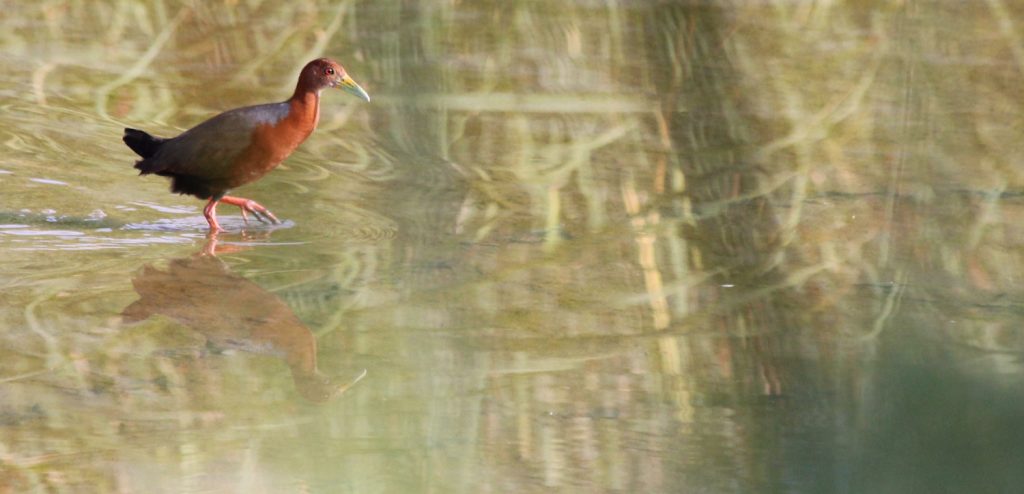
Rufous-necked Wood-Rail. Photo by Matt York
Summer Wildlife Management Activity Checklist
By Kameron Bain, Business Development Manager
Today may be the first day of summer, but the hot temperatures have already arrived. For many Texas landowners, it may be hard to think about getting on your land to conduct wildlife management activities. However, there are some key activities that are done in the summertime. If you are finding yourself behind at this half way point then now is a good time to take advantage of the long days and this long list of activities to get back on track:
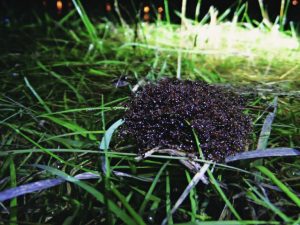
- Chemical Control
- MLDP Paperwork – due August 15
- Deer Surveys – start in August
- Pond Construction
- Pond Renovation and Repair
- Imported Red Fire Ant Control
- Strip Mowing – late July and August
- Half-cutting
- Supplemental Water Maintenance
- Small Mammal Surveys
The Presents of Presence
By James Hall, Staff Biologist II
A little over twenty years ago, the internet was made fully commercially available in the United States, unlocking a wealth of shared information, news, commercialization, and the ubiquity of social media. Around that same time, Plateau Land & Wildlife Management was conceived by legislation that allowed landowners with an agricultural valuation to obtain the same tax savings while managing for native wildlife and habitat.
The knowledge required to become a superior steward of your property exists at your fingertips through the vast world wide web. However, there can be no substitute for having a professional visit with you, observe the wild things that occupy your land, and listen to the story of your property goals and aspirations. We take great pride in providing assistance during this adventure and staying connected long after we’ve trekked through your property.
One way you can stay connected with us is through our ever-expanding social media presence. Our quarterly Seasons e-newsletter that you are reading now provides original articles, information, and seasonally appropriate wildlife activities to keep your plan on track and keep you updated on Wildlife Management in Texas. Plateau prepares bi-weekly newsletters and posts on Facebook such as the aptly named “Plateau Post,” which shares interesting editorials and current events.
Be sure to check out our newest weekly contribution, “Flora and Fauna Friday” – every Friday on Facebook, one of our team members will post a fresh mini-article about a unique and fascinating critter or plant that is found in Texas. We also have a wide variety of informative webinars by our professional team, fun and instructional videos, emails, booklets, and other media available on our website. Plateau is on LinkedIn as well, and our presence on Twitter and Instagram is coming soon.
Help us celebrate our 20th year by liking us, sharing us, and referring us. If you are not inclined towards social media, then check out our website, call us, or stop by and visit. We are passionate about land and want to ensure that you obtain your goals while contributing to the proper management of our natural heritage in this great state. Let us inform you as well as entertain you!
Back to TopBack to Top
Plateau Summer Webinar Series
Join Plateau every other Wednesday for our Summer Webinar Series. All webinars will begin at 12 pm. For a full list of webinars and webinar recordings visit our webinars web page.
Back to TopBack to Top
Service Spotlight: Annual Reports
By David Riley, Staff Biologist
Each year many Central Appraisal Districts (CADs) request annual reports from Texas landowners in wildlife management. This is a way for them to ensure that landowners are in compliance with their wildlife management activities without the appraiser having to visit their property. As we reach midyear we want to remind wildlife management landowners to be aware of this and remind them of the importance of good record keeping.
Most counties require your annual report to be submitted prior to April 30 of the following year. Plateau offers a service to take this weight off your shoulders. A Plateau Annual Report is thoroughly prepared by a Plateau biologist and includes a Texas Parks & Wildlife annual report form, all activity documentation, and the peace of mind that your wildlife management valuation stays in place for only $495.
Plateau does more than 500 of these each year. We maintain great relationships with all the CADs and know precisely what information they will want to see. With more and more CADs requesting this report every year it is essential that qualifications are met and well documented for each year on all wildlife management properties. A well-done and complete annual report can make all the difference.
Record Keeping Tips:
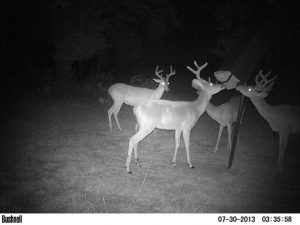
- Always take photos of your activities
Take new photos every year even if nothing has changed
Be sure to take before and after photos of activities like brush management
If you think that it is a wildlife management activity then you should take a photo of it - Keep accurate logs of the activities conducted
Keep a log book at the property or in the vehicle/UTV you use around the property
Keep accurate logs at the time you do the activity so you don’t have to remember it later
Follow this link to downloadable activity logs - Refer to your wildlife management plan
Your wildlife management plan is your guide to what activities might be best for your targeted species
This can help ensure that you are meeting minimum intensity requirements with your activities - Keep receipts for all wildlife management activities
This can be for feed, nest box parts, brush management equipment, etc. - Organize all documentation by activity
This makes it easier for you to see exactly what you have done throughout the year and becomes a checklist to ensure that you meet minimum requirements (minimum requirement is 3 of the 7 activity categories) - Utilize maps when possible
Mark areas where feeders, water sources, nest boxes, etc. are located
Draw areas where brush management, erosion control, fire ant treatment, etc. occur
A Recap of the Texas Legislative Session
By Jenna Brockman, Legal Assistant at Braun & Gresham, PLLC
May 29th marked the end of the 85th Texas Legislative Session. Over 10,000 bills were introduced in the House and Senate this session; almost 5,000 bills passed, and a little over 1,000 have been signed by the governor. As advocates for Texas landowners, Braun & Gresham diligently monitored bills that could likely affect rural landowners. We work to protect you from unfair law, and we are committed to create, expand on and defend good law. Few Texans have the time and resources to track movement of legislation. As we help you obtain conservation easements, defend you in condemnation cases or protect you at the appraisal districts, we are also operating behind the scenes at the Texas Capitol to preserve your landowner rights.
We put together a short list (below) of bills that we followed. These bills have been signed into law by Governor Abbott. In the future, if you are curious about following actions in the legislature, one way to do so is via the internet at capitol.state.tx.us/Home.aspx.
HB 777 – Relating to the eligibility of land owned by certain members of the armed services of the United States for appraisal for ad valorem tax purposes as qualified open-space land.
capitol.state.tx.us/BillLookup/History.aspx?LegSess=85R&Bill=HB777
Plain English summary: HB 777 will help ensure that deployed military members who are unable to continue using land for agricultural purposes are not unexpectedly hit with a large tax bill. HB 777 will help landowners avoid rollback taxes by extending the agricultural valuation until the owner is able to manage the land.
HB 3198 – Relating to the eligibility of land to continue to be appraised for ad valorem tax purposes as qualified open-space land if the land begins to be used for oil and gas operations
capitol.state.tx.us/BillLookup/History.aspx?LegSess=85R&Bill=HB3198
Plain English summary: The eligibility of land qualified for open-space land does not end because the owner begins an oil and gas operation so long as the land that is not being used for oil and gas operation continues to qualify for open-space.
SB 594 – Relating to the procedure for the approval of rules adopted by the comptroller relating to the appraisal of qualified open-space land and qualified timber land for ad valorem tax purposes.
capitol.state.tx.us/BillLookup/History.aspx?LegSess=85R&Bill=SB594
Plain English summary: The comptroller will approve a set of rules related to the appraisal of qualified open-space and timber land. The Comptroller will then create a manual that contains the approved set of rules, and the comptroller will distribute the manual to each appraisal office. The rules must be approved by the Department of Agriculture. Each appraisal office will use the manual to enforce procedures to verify that the land meets the necessary requirements to approve open-space and/or timber land.
SB 762 – Relating to the prosecution of offenses involving cruelty to animals; increasing a criminal penalty
capitol.state.tx.us/BillLookup/History.aspx?LegSess=85R&Bill=SB762
Plain English summary: S.B. 762 will increase the punishment for violent animal cruelty offenses and will address certain loopholes in current statute. S.B. 762 amends current law relating to the prosecution of offenses involving cruelty to animals. S.B. 762 also cleans up language to make activities such as hunting, fishing, trapping, wildlife management, or animal husbandry a defense to the prosecution rather than an exception.
SB 1459 – Relating to incentives to encourage landowners to destroy, remove, or treat citrus trees located in a pest management zone.
capitol.state.tx.us/BillLookup/History.aspx?LegSess=85R&Bill=SB1459
Plain English summary: A landowner will not lose his or her agriculture valuation because of a decrease in productivity if the landowner is located in a pest management zone and chooses to destroy, remove or treat citrus trees that are or could become infested with pests.
Keeping up with issues that affect Texas landowners is easy with Braun & Gresham’s landowner alert system (“LAS”). This free email service comes out once every two weeks and gives subscribers exclusive access to a range of information: from announcements about important changes in the law to alerts about upcoming educational seminars. Anyone interested in Texas land will benefit from the LAS. Follow this link and spend 10 seconds choosing your areas of interest!
Back to TopBack to Top
Plateau Land Group Featured Listing
High-End Home, Guest Casita, Luxury Breeding Barn w/ Apartment & Lounge Wimberley, Hays County, TX $1,387,900
 18-Acre Hill Country Equestrian Homestead
18-Acre Hill Country Equestrian Homestead
Dreams do come true at Rainbows End Ranch. Featuring a high-end home, guest casita, and luxury breeding barn with apartment and lounge -horses, family, and friends all have a place to call their own. Invest in a Hill Country homestead with style and functionality. The sellers have raised their family and the property is ready for its next life, hosting an equestrian lifestyle that demands the best Texas can offer with Hill Country views, grand entertaining areas, and all the amenities needed to enjoy country living.
View all of Plateau Land Group’s listings.
Back to TopBack to Top




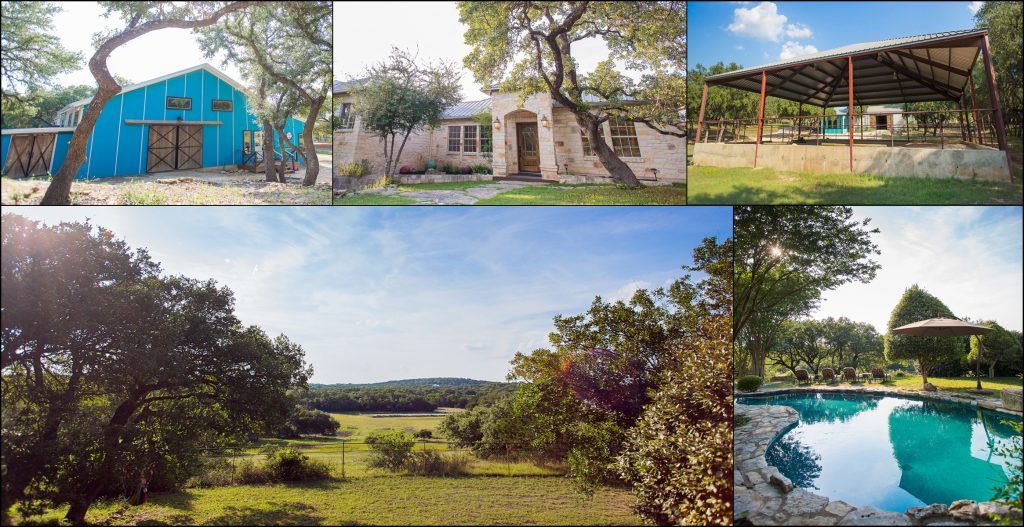



Sorry, the comment form is closed at this time.